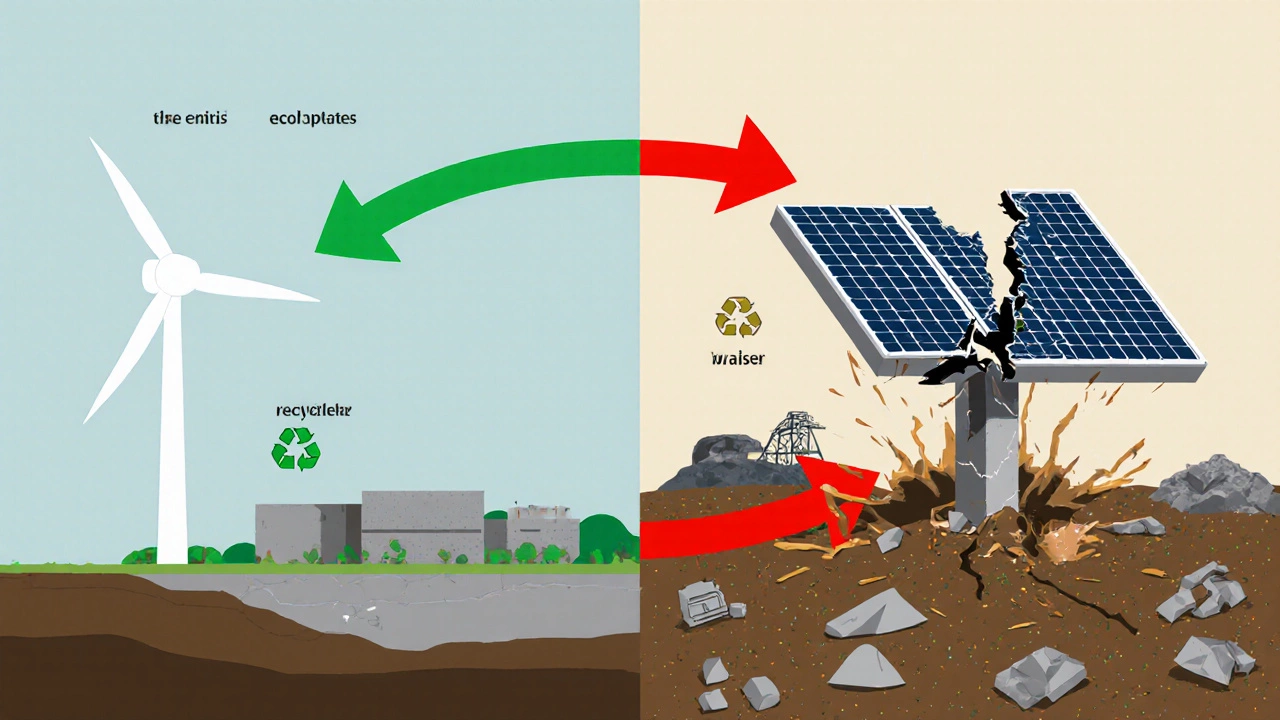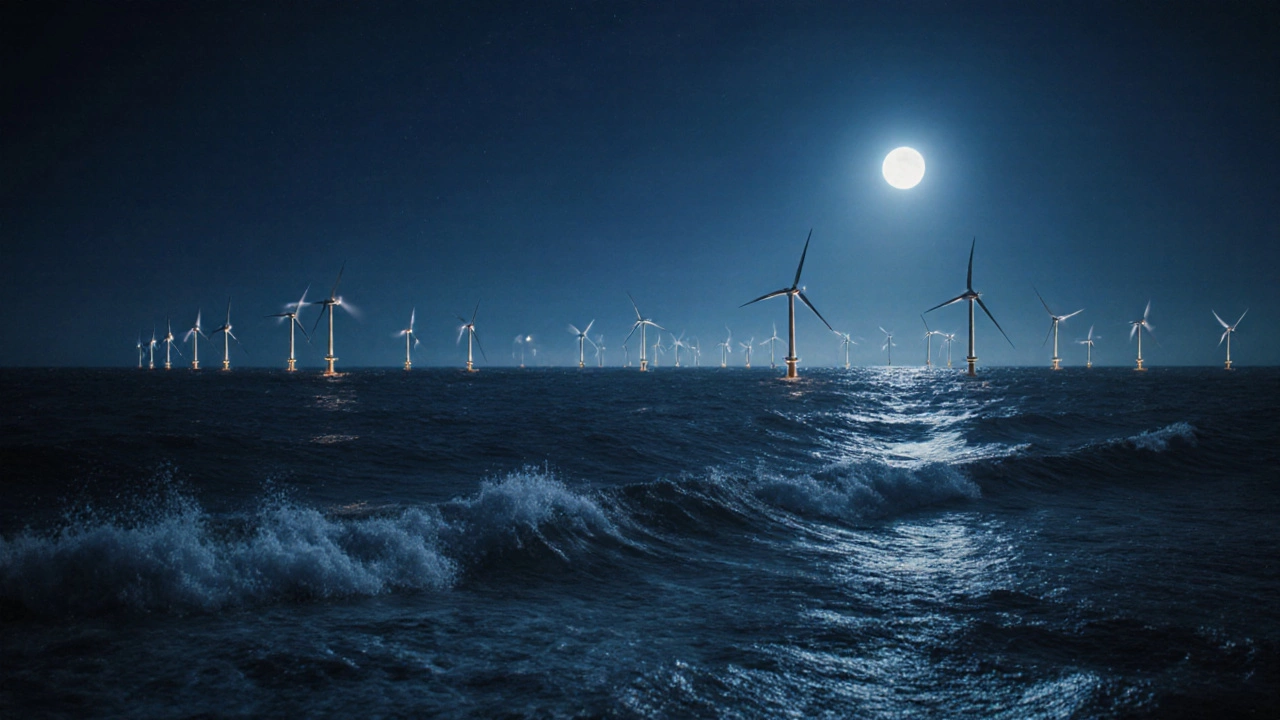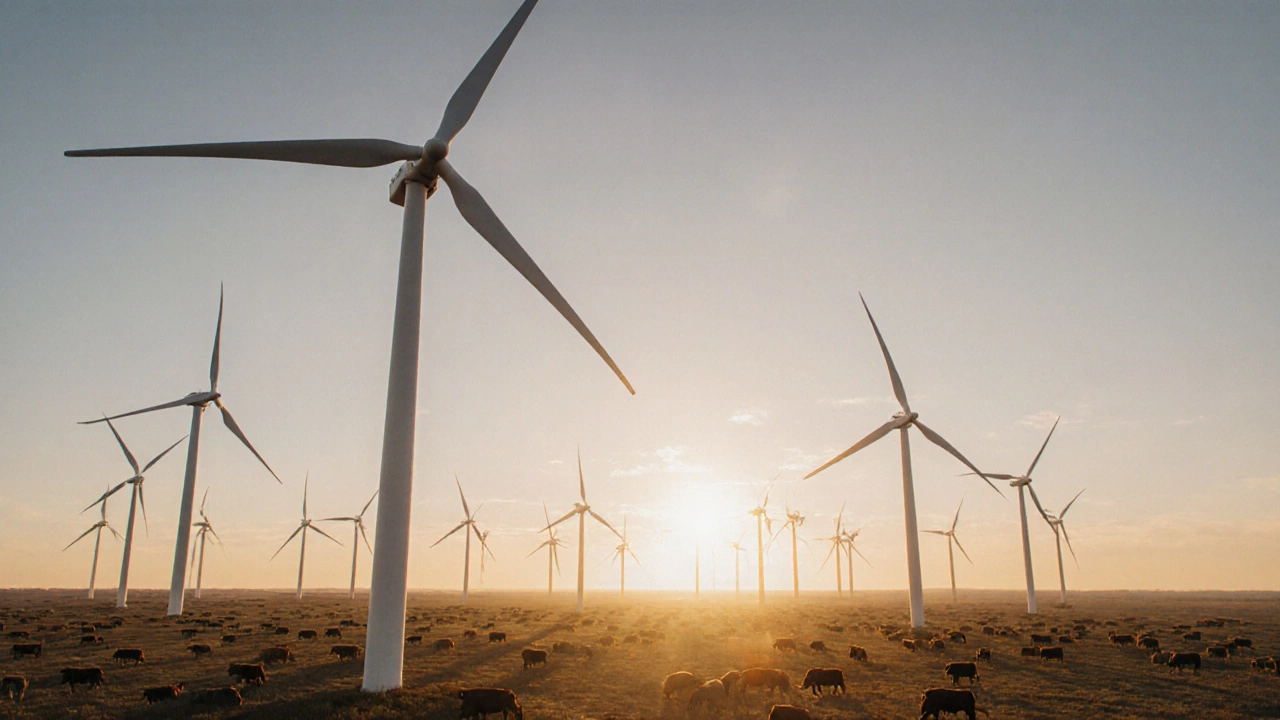Energy Source Emissions Calculator
How clean is your energy mix?
Compare the life cycle emissions of different energy sources using real data from the International Energy Agency and Stanford University research.
Emissions Comparison
When people ask what the cleanest form of energy is, they’re usually thinking about zero emissions. But clean isn’t just about smokestacks or carbon output. It’s about the whole life cycle - from mining materials to decommissioning equipment. And when you look at all the numbers, one source stands out clearly: wind power.
Why Wind Power Wins on Cleanliness
Wind turbines don’t burn fuel. They don’t release CO2 while running. They don’t pollute water. They don’t produce ash or radioactive waste. That’s why, in life cycle assessments by the International Energy Agency and the National Renewable Energy Laboratory, wind energy consistently ranks as the lowest-emitting power source on Earth.
A 2023 study from Stanford University tracked emissions from cradle to grave for all major energy sources. Wind came in at 11 grams of CO2 equivalent per kilowatt-hour. Solar photovoltaic? 45 grams. Natural gas? 490 grams. Coal? Over 1,000 grams. Even nuclear - often called clean - hits 12 grams, barely ahead of wind. But here’s the catch: nuclear needs uranium mining, long-term waste storage, and massive water cooling systems. Wind doesn’t.
Wind farms also use less land per unit of energy than almost anything else. A single turbine can generate enough power for 1,500 homes. The land underneath can still be used for farming or grazing. In Texas and Iowa, farmers earn extra income by leasing land to wind companies while continuing to grow corn or raise cattle.
What About Solar?
Solar panels are everywhere now - rooftops, parking canopies, desert farms. And they’re getting cheaper. But they’re not as clean as wind when you look at the full picture.
Manufacturing solar panels requires silicon, silver, copper, and rare earth elements. Mining these materials causes soil erosion, water contamination, and habitat loss. The production process uses toxic chemicals like hydrofluoric acid. Even recycling solar panels is still a challenge: only about 10% of panels in the U.S. are recycled today. The rest end up in landfills.
And while solar panels last 25-30 years, their efficiency drops over time. By year 25, most produce only 80% of their original output. Wind turbines, by comparison, maintain 95%+ efficiency for decades with simple maintenance.
Hydropower: Clean on the Surface, Damaging Below
Hydroelectric dams look clean - no smoke, no fuel. But they come with hidden costs. Reservoirs flood forests and wetlands, releasing methane as organic matter decays underwater. In tropical regions, some dams emit more methane per kWh than natural gas plants.
They also disrupt river ecosystems. Fish like salmon can’t migrate past dams. Water temperatures change, killing aquatic life. And when droughts hit - like in California or the Colorado River Basin - hydropower output crashes. In 2022, U.S. hydropower generation dropped 18% from the previous year due to low water levels.
Plus, building big dams takes decades and billions of dollars. The Three Gorges Dam in China cost $37 billion and displaced 1.3 million people. Wind farms? You can build a 100-megawatt project in under a year.

Nuclear: High Output, High Risk
Nuclear energy has low emissions - yes. But it’s not clean in the way people mean when they ask this question.
It produces no CO2 during operation. But it creates high-level radioactive waste that remains dangerous for thousands of years. No country has a permanent storage solution yet. The U.S. has over 86,000 metric tons of spent nuclear fuel sitting in temporary pools and dry casks at 75 sites across 35 states.
Accidents, though rare, are catastrophic. Chernobyl and Fukushima still affect regions decades later. And nuclear plants need massive amounts of water to cool - water that’s becoming scarcer in a warming world. A single reactor can use 20 million gallons of water per day. Wind uses zero.
Why Biomass and Geothermal Don’t Top the List
Biomass - burning wood, crops, or waste for energy - is often marketed as renewable. But it releases carbon dioxide and particulate matter. In fact, burning wood emits more CO2 per kWh than coal, according to the European Environment Agency. It’s only considered carbon-neutral if you assume the trees regrow immediately - which rarely happens at scale.
Geothermal is solid. It’s reliable, low-emission, and works 24/7. But it’s location-limited. You need tectonic activity - think Iceland or parts of California. It can’t be deployed in most of the U.S. or Europe. Wind and solar can go anywhere there’s air and sun.
The Real Winner: Wind Power
Wind power has the lowest emissions, the smallest land footprint, the fastest deployment, and the least environmental damage across its entire life cycle. It doesn’t require rare earths in large quantities. Modern turbines use mostly steel, concrete, and copper - all highly recyclable.
And the technology keeps improving. New turbines are taller, with longer blades, capturing more wind at lower speeds. Offshore wind farms are now producing power at costs lower than coal in many markets. In 2024, the average levelized cost of wind energy in the U.S. was $26 per megawatt-hour - cheaper than natural gas at $42 and coal at $68.
Wind doesn’t just beat other renewables on cleanliness - it beats fossil fuels by a factor of 50 to 100 times in emissions reduction. And unlike solar, it doesn’t rely on a supply chain tied to child labor in cobalt mines or toxic chemical spills in silicon refineries.

Is Wind Perfect? No. But It’s the Best We Have
Wind turbines kill birds - yes. But studies show that cats, buildings, and cars kill millions more. Wind causes less than 0.01% of human-caused bird deaths. Modern turbines are also designed with slower rotation speeds and better placement to reduce impact.
Some people complain about noise or looks. Those are subjective. But the data doesn’t lie: wind is the cleanest, most scalable, and most sustainable energy source we’ve ever built.
Switching to wind at scale could cut global electricity emissions by 80% by 2040. That’s the kind of impact that actually moves the needle on climate change. No other energy source comes close.
What About Storage and Reliability?
People say wind isn’t reliable because the wind doesn’t blow all the time. That’s true - but it’s also outdated thinking.
Today’s grids use a mix of wind, solar, batteries, and smart demand response. When the wind drops, solar might be peaking. When both are low, batteries discharge. Grid operators now use AI to predict wind patterns with 95% accuracy 48 hours ahead.
And storage is getting cheaper. Lithium-ion battery prices have fallen 90% since 2010. New flow batteries and compressed air systems are coming online. In 2025, the U.S. has over 100 gigawatts of battery storage under construction - enough to cover several days of wind lulls.
Wind doesn’t need to work 24/7 by itself. It works as part of a smarter, more flexible system - one that’s already here.
Final Thought: Clean Isn’t Just About Emissions
True cleanliness means no long-term damage. No poisoned water. No radioactive waste. No displaced communities. No irreversible ecosystem collapse.
Wind power checks every box. It’s scalable. It’s affordable. It’s deployable. And it’s already delivering results - from rural Kansas to the North Sea.
If you care about clean energy, don’t get distracted by hype. Look at the data. Wind power is the cleanest form of energy we have - and it’s only getting better.
Is nuclear energy cleaner than wind?
Nuclear has slightly lower emissions than wind - 12 grams vs. 11 grams of CO2 per kWh - but it creates long-lasting radioactive waste, requires massive water use, and carries catastrophic risk if accidents occur. Wind produces no waste, uses no water, and has no meltdown risk. So while nuclear is low-carbon, wind is cleaner overall.
Why isn’t solar the cleanest energy source?
Solar panels have a higher environmental cost during manufacturing than wind turbines. They rely on mining rare metals, use toxic chemicals, and have poor recycling rates. While they emit no pollution while running, their full life cycle emissions are over four times higher than wind. Wind wins on sustainability from start to finish.
Does wind power harm wildlife?
Wind turbines do kill birds and bats, but the number is tiny compared to other human causes. Cats, buildings, and vehicles kill hundreds of millions of birds annually in the U.S. alone. Wind accounts for less than 0.01% of human-caused bird deaths. Newer turbine designs and smarter placement have reduced impacts by over 70% since 2010.
Can wind power replace coal and gas completely?
Yes - and it already is in many places. Denmark gets over 50% of its electricity from wind. Texas produces more wind power than the entire country of Portugal. With better storage, grid upgrades, and smart demand systems, wind and solar can fully replace fossil fuels in the electricity sector by 2035, according to the International Renewable Energy Agency.
Is offshore wind cleaner than onshore wind?
Offshore wind has slightly higher emissions from installation because of the need for underwater cables and specialized ships. But it generates more power per turbine due to stronger, steadier winds. Over its lifetime, offshore wind still has the lowest emissions per kWh of any energy source. It’s also farther from homes, reducing noise and visual concerns.




